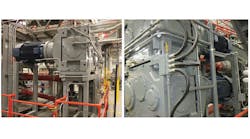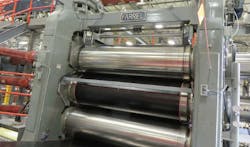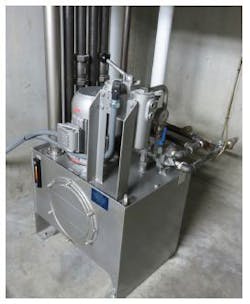In order to extend production, Legg Co., Halstead, Kans., which fabricates industrial conveyor belts, decided to purchase a machine that could produce 8-ft-wide belts as opposed to the 6-ft-wide belts they were making. Developing a new calender — a series of rollers that lay rubber onto fabric for sturdier belts — was not without challenges. After finding the required frames, Legg looked to suppliers for suitable drives.
Space constraints and power requirements limited expanding the production size of the current calender. Multiple drives, one per roller, when placed in a new configuration in order to fit, created issues regarding mounting. Whereas a single-drive system automatically distributes power for each roll, a multidrive setup necessitates maximum load requirements per roller so each drive can operate with power to spare.
With the help of an engineering consultant, Legg turned to Nord DriveSystems, Waunakee, Wis., which previously supplied drives for most of Legg’s plant. Customizing Nord’s Maxxdrive SK15307V NEMA449TC drives and stacking them three high (with a fourth to the side) ensures sufficient support for the 32-in.-diameter rollers. The drives, based on a helical-parallel shaft design, have an input speed of 1,170 rpm, an output speed of 15 rpm, and a torque rating of 1,850,000 lb-in.
The stacked arrangement lets Legg use shorter driveshafts, but the weight of the stacked units made the overall machine difficult to install. A cast-iron supports lets the stacked units take most of the compression loads, which especially affects bending moments and the bottom case of stack. This additional support ensures the attachment flanges are not overstressed. A central lubrication subsystem fed from a remote reservoir helps control thermal loads.
Designing the calender so that each roller is separately driven by its own drive gives Legg more precise process control. Further, the finishing mills that feed rubber to the calender upstream for warm-up use the same size drives. Several rewind stands use similar drives for downstream power. A total of 18 Nord drives power the entire Legg calender line, which has been operational for over a year.



